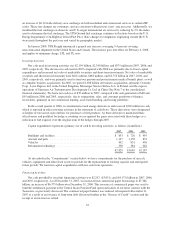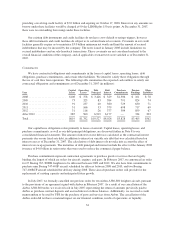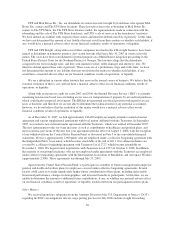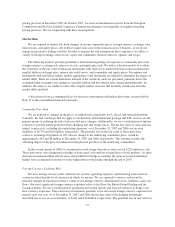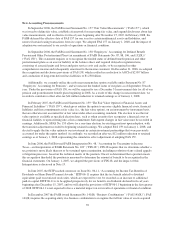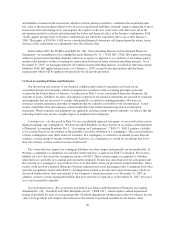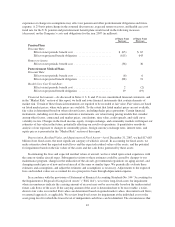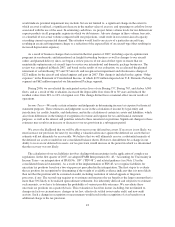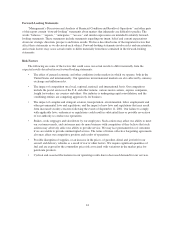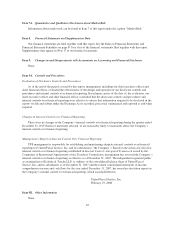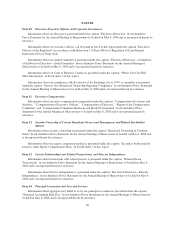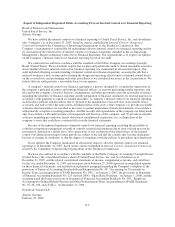UPS 2007 Annual Report Download - page 57
Download and view the complete annual report
Please find page 57 of the 2007 UPS annual report below. You can navigate through the pages in the report by either clicking on the pages listed below, or by using the keyword search tool below to find specific information within the annual report.
experience or changes in assumptions may affect our pension and other postretirement obligations and future
expense. A 25 basis point change in the assumed discount rate, expected return on assets, and health care cost
trend rate for the U.S. pension and postretirement benefit plans would result in the following increases
(decreases) on the Company’s costs and obligations for the year 2007 (in millions):
25 Basis Point
Increase
25 Basis Point
Decrease
Pension Plans
Discount Rate:
Effect on net periodic benefit cost .......................... $ (65) $ 67
Effect on projected benefit obligation ....................... (615) 643
Return on Assets:
Effect on net periodic benefit cost .......................... (36) 36
Postretirement Medical Plans
Discount Rate:
Effect on net periodic benefit cost .......................... (6) 6
Effect on projected benefit obligation ....................... (88) 91
Health Care Cost Trend Rate:
Effect on net periodic benefit cost .......................... 2 (2)
Effect on projected benefit obligation ....................... 19 (19)
Financial Instruments—As discussed in Notes 2, 3, 8, and 15 to our consolidated financial statements, and
in the “Market Risk” section of this report, we hold and issue financial instruments that contain elements of
market risk. Certain of these financial instruments are required to be recorded at fair value. Fair values are based
on listed market prices, when such prices are available. To the extent that listed market prices are not available,
fair value is determined based on other relevant factors, including dealer price quotations. Certain financial
instruments, including over-the-counter derivative instruments, are valued using pricing models that consider,
among other factors, contractual and market prices, correlations, time value, credit spreads, and yield curve
volatility factors. Changes in the fixed income, equity, foreign exchange, and commodity markets will impact our
estimates of fair value in the future, potentially affecting our results of operations. A quantitative sensitivity
analysis of our exposure to changes in commodity prices, foreign currency exchange rates, interest rates, and
equity prices is presented in the “Market Risk” section of this report.
Depreciation, Residual Value, and Impairment of Fixed Assets—As of December 31, 2007, we had $17.663
billion of net fixed assets, the most significant category of which is aircraft. In accounting for fixed assets, we
make estimates about the expected useful lives and the expected residual values of the assets, and the potential
for impairment based on the fair values of the assets and the cash flows generated by these assets.
In estimating the lives and expected residual values of aircraft, we have relied upon actual experience with
the same or similar aircraft types. Subsequent revisions to these estimates could be caused by changes to our
maintenance program, changes in the utilization of the aircraft, governmental regulations on aging aircraft, and
changing market prices of new and used aircraft of the same or similar types. We periodically evaluate these
estimates and assumptions, and adjust the estimates and assumptions as necessary. Adjustments to the expected
lives and residual values are accounted for on a prospective basis through depreciation expense.
In accordance with the provisions of Statement of Financial Accounting Standards No. 144 “Accounting for
the Impairment or Disposal of Long-Lived Assets” (“FAS 144”), we review long-lived assets for impairment
when circumstances indicate the carrying amount of an asset may not be recoverable based on the undiscounted
future cash flows of the asset. If the carrying amount of the asset is determined not to be recoverable, a write-
down to fair value is recorded. Fair values are determined based on quoted market values, discounted cash flows,
or external appraisals, as applicable. We review long-lived assets for impairment at the individual asset or the
asset group level for which the lowest level of independent cash flows can be identified. The circumstances that
42


